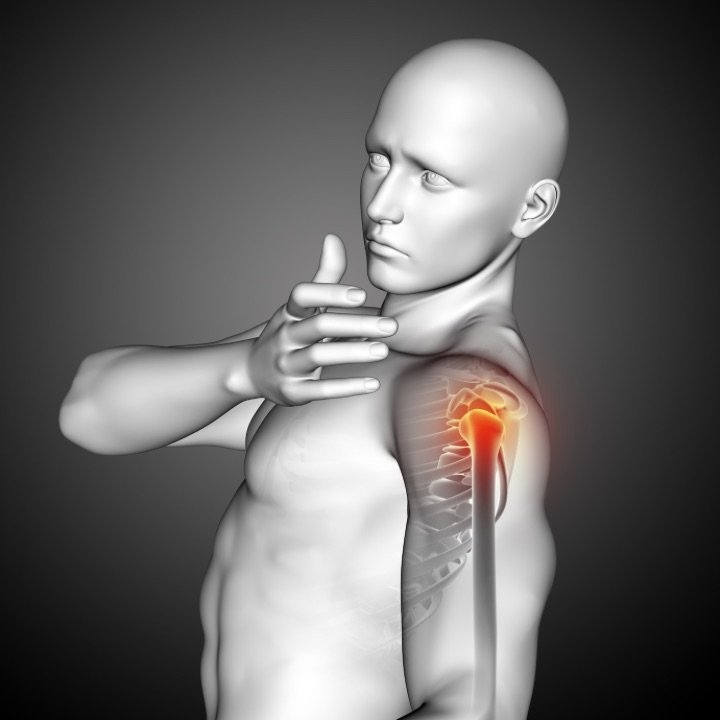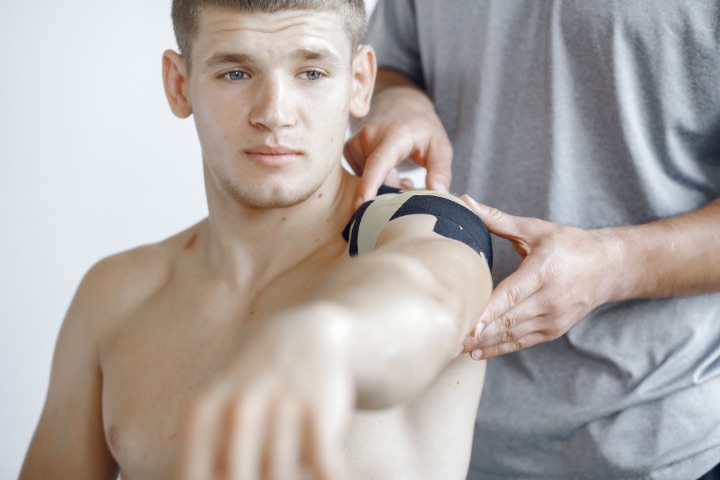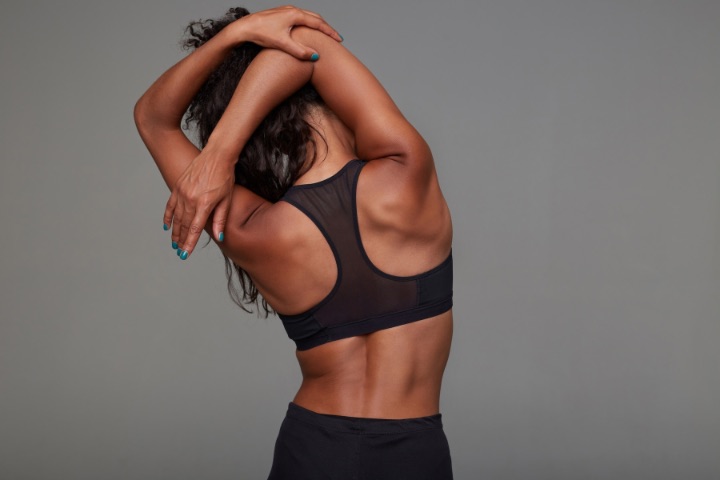AC joint injury is a common type of shoulder injury from trauma or overuse. Understanding the symptoms, causes, and treatment options for a comprehensive recovery.
The acromioclavicular (AC) joint is located at the junction of the acromion process of the scapula and the clavicle bone. It is a small joint that is essential to shoulder movement and stability.
The AC joint is held together by many ligaments and is supported by surrounding muscles. These structures work together to keep the joint stable while allowing for mobility.
The vulnerability of the AC joint to injury is due to its position between the scapula and the clavicle. This joint can be affected by trauma or overuse, leading to various degrees of damage.
The acromioclavicular joint is a small, yet essential joint that connects the clavicle to the scapula and plays a vital role in shoulder movement and stability.

Photo Credit: kjpargeter
The AC joint is a synovial joint, which means that it has a joint capsule and synovial fluid to reduce friction between the bones. It is classified as a gliding joint, allowing the clavicle to move upward and downward while gliding on the acromion process.
AC joint injuries can cause significant discomfort and affect mobility in the shoulder joint. The symptoms experienced by individuals with an AC joint injury can vary depending on the severity of the injury. Common symptoms of AC joint injury include:
Pain is the most common symptom of AC joint injury.
If you are experiencing any of these symptoms, seeking medical attention to determine the cause of your discomfort and receiving appropriate treatment is important.
The AC joint, although small, is a critical component of the shoulder joint complex. Therefore, any force or trauma to this area can result in an AC joint injury. The following are some of the most common causes of AC joint injuries.
Individuals with a naturally sloping or downward-facing AC joint may be more susceptible to AC joint injuries. Additionally, individuals with a collarbone that extends farther than the shoulder blade may be at increased risk of injury.
AC joint injuries are common in individuals who participate in contact sports such as football, wrestling, and hockey, which involve direct contact or falls onto the shoulder. Repetitive overhead movements, such as those seen in tennis, baseball, or weightlifting, can also lead to AC joint injuries.
Many AC joint injuries result from falls onto the shoulder or landing on an outstretched hand. Falls from a bike, skateboard, or a height can also cause AC joint injuries.
A direct blow to the shoulder, such as in a car accident or an assault, can lead to an AC joint injury.
It is important to note that some individuals may be more susceptible to AC joint injuries, and that any injury can vary in severity depending on the force and direction of impact.

Photo Credit: prostooleh
Treatment for AC joint injuries depends on the severity of the injury and the individual’s overall health. In most cases, conservative treatment methods are sufficient to manage pain and promote healing.
Conservative treatments for AC joint injuries may include rest, ice, compression, and elevation to reduce pain and swelling. Physical therapy exercises may also be recommended to improve the shoulder joint’s strength, flexibility, and range of motion. Medications like nonsteroidal anti-inflammatory drugs (NSAIDs) may also be prescribed to manage pain and inflammation.
Conservative treatments for AC joint injuries may include rest, ice, compression, and elevation to reduce pain and swelling.
Surgery may be recommended if conservative treatments are unsuccessful in managing symptoms or if the injury is severe. The type of surgery performed will depend on the extent of the injury and may include:
Your doctor will discuss the best surgical option for your specific injury and inform you of each surgical technique’s potential risks and benefits.
The recovery process for AC joint injuries can vary depending on the severity of the injury and the type of treatment received. Conservative treatment methods may require several weeks to several months of rehabilitation and physical therapy to regain full function of the shoulder joint. Surgery may require a longer recovery period, typically 4-6 months.
Following your doctor’s instructions for rehab and recovery is essential to avoid re-injury or further complications. Your doctor may also recommend follow-up appointments or additional imaging tests to monitor your progress and ensure your shoulder joint is healing correctly.

Photo Credit: nakaridore
Rehabilitation plays a crucial role in the recovery process of AC joint injuries. It involves a combination of physical therapy and exercises to reduce pain and restore strength, stability, and range of motion. Here are some rehabilitation techniques and exercises that can help:
Resting the shoulder joint and applying ice can help reduce pain and inflammation in the early stages of the injury. The RICE (Rest, Ice, Compression, and Elevation) method is often recommended by healthcare professionals and can help manage symptoms.
A physical therapist can design a specific rehabilitation program tailored to the needs of the patient. The therapy may include range-of-motion, strengthening, and strategies to improve posture and body mechanics. Physical therapy can help improve the overall function of the shoulder and speed up recovery.
Strengthening exercises are essential for restoring the stability of the injured AC joint. The type of exercises recommended will depend on the severity of the injury. Some examples of exercises that can be helpful include shoulder blade squeezes, external rotation exercises, and resisted supination exercises.
Range-of-motion exercises can improve the flexibility and mobility of the shoulder joint. These exercises may include pendulum exercises, wall climbing, and table slides.
These types of exercises aim to improve the coordination and control of the muscles surrounding the AC joint. Examples may include scapular retraction exercises and proprioception training.
Note: It’s important to always consult with a healthcare professional before attempting any exercises or rehabilitation techniques for an AC joint injury. Improper technique or overexertion can lead to further injury or complications.
The recovery time for an AC joint injury can vary depending on the severity of the injury and the type of treatment received. In general, conservative treatments like rest, ice, and physical therapy can allow for gradual improvement over several weeks to a few months. Surgery may require a longer recovery period of several months.
Not all AC joint injuries require surgery. In fact, conservative treatments like rest, ice, physical therapy, and medication can often lead to successful recovery. Surgery may be recommended in cases of severe injury or if conservative treatments fail to provide relief.
In some cases, individuals with AC joint injuries may experience long-term complications like chronic pain, limited range of motion, or weakness in the shoulder. This can be more likely if the injury is severe or if it was not properly treated.
While not all AC joint injuries can be prevented, you can take steps to reduce your risk. This includes using proper form and techniques during sports or physical activities, wearing appropriate protective gear, and avoiding overuse or repetitive movements that can strain the shoulder joint.
Yes, exercises can play a crucial role in the recovery process of an AC joint injury. Physical therapy can help restore strength, stability and range of motion to the shoulder joint. Exercises like shoulder rotations, scapular squeezes, and wall push-ups can also aid rehabilitation.
Your healthcare provider can provide more information on AC joint injuries and recommend specific resources. Additionally, reputable healthcare websites or organisations like the American Academy of Orthopaedic Surgeons can provide additional information on symptoms, causes, treatments, and prevention of AC joint injuries.